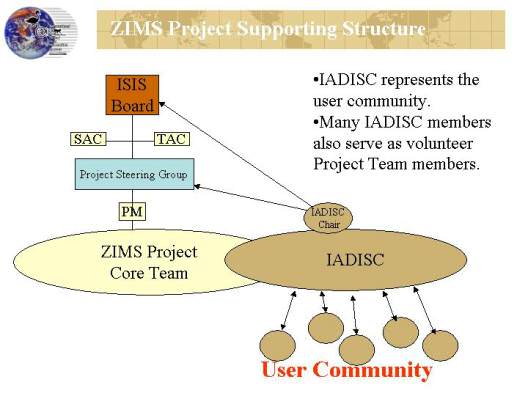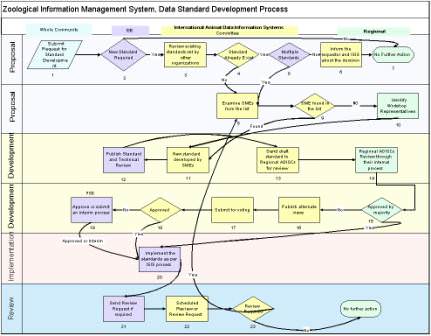Report
from the IADISC
WORKING GROUP
CBSG
meeting November 14, 2003, El Roble Puntarenas, Costa Rica
|
Working
Group Participants |
|
|
Name |
Institution |
|
Bruce Bohmke |
Woodland Park Zoo |
|
Duncan Bolton |
Bristol Zoo Gardens |
|
Jeffrey Bonner |
St. Louis Zoo |
|
Dan Brands |
Great Plains Zoo |
|
Frands Carlsen |
Copenhagen Zoo |
|
Sue DuBois |
Disney |
|
Nate Flesness |
ISIS |
|
Jo Gipps |
Bristol Zoo Gardens |
|
Kazuyoshi Itoh |
Tokyo Zoo |
|
Dennis Meritt |
Depaul University |
|
Magaly Ojeda |
FUNPZA Venezuela |
|
Mark Stanley Price |
Durrell Wildlife Conservation Trust |
|
Radoslaw Ratajszczak |
Poznan Zoo |
|
Karin Schwartz |
Milwaukee County Zoo |
|
Beth Stevens |
Disney |
|
Kazutoshi Takami |
Osaka Zoo |
|
Eric Tsao |
Taipei Zoo |
|
Dave Wildt |
National Zoo |
The
International Animal Data Information Systems Committee (IADISC), www.iadisc.org,
serves as a global forum for the user community’s
participation in the planning, design, development, and deployment of a new
Zoological Information Management System (ZIMS), www.zims.org.
The
ZIMS Project was initiated in 2001 by the user community and ISIS to address the
need for an improved global animal information system and is currently managed
by ISIS.
IADISC
was established in 2001 to ensure international user representation in the
process throughout the building of ZIMS. The most recent annual meeting was held
November 12-13, 2003 in Costa Rica. This
particular meeting was important in defining the specific responsibilities that
IADISC has in supporting the ZIMS Project. IADISC representatives include:
·
ACOPAZOA – Maria Clara Dominquez
·
AMACZOOA – Danilo Leandro
·
ARAZPA – Kevin Johnson
·
AZA – Bruce Bohmke, Robert Erhardt, Bob Cook, Andy Odum, Sue DuBois
·
CAZA – John Carnio
·
EAZA – Frands Carlsen, Duncan Bolton
·
FUNPZA – Magaly Ojeda
·
JAZA – Kazuyoshi Itoh, Kazutoshi Takami
·
PAAZAB – Ian Espie, Dave Morgan
·
SAZARC – Sally Walker
·
SEAZA - pending
·
Taiwan – Eric Tsao
ZIMS
Project Update
In Phase
I of the ZIMS Project, a high-level plan, mission and charter defining the scope
of ZIMS and development cost estimate were created. In Phase II, an RFP (Request
for Proposals) was developed with detailed description core and veterinary
system requirements. In July 2003, ISIS hired a full-time ZIMS Project Manager
and Chief Technology Officer, Syed Hassan. Subsequently, the RFP for ZIMS
development was released in September, 2003. An international evaluation
committee is currently reviewing proposals from 9 vendors. The selected vendor
will begin design and development of ZIMS in early 2004.
The ZIMS capital campaign has so far raised over $3 million in written
and verbal pledges from more than 100 institutions for the first phase of ZIMS
development (core and veterinary to replace ARKS, SPARKS and MedARKS) and has
plans to broaden the campaign to corporate and foundation sources.
The
initial high-level estimate for the completion of ZIMS, including several
modules beyond this Phase 1, was roughly $26 million. Phase 1 was estimated at
$10 Million. It is important to note that a significant portion of this estimate
includes the cost for professional documentation, preparation of sophisticated
materials needed by the software vendor, and for ‘consensus adjustment’.
Consensus adjustment represents the cost for gaining agreement on how the system
is designed particularly since it may result in changes to business processes
and will absolutely require the review and development of new data standards.
This will require many workshops. Because much of this work must be performed by
the users of the system, IADISC will play an important role in facilitating user
involvement, engaging new stakeholders in the process and communication project
and system progress. Thus, a large
part of the cost for consensus adjustment will be offset by the volunteer
efforts of IADISC, workshop participants and their institutions. The ISIS Board
is addressing ways to meet the operational costs for supporting ZIMS which were
not included in the development estimate.
Role
of IADISC
The role
of IADISC includes:
·
Promoting and
coordinating the involvement of Subject Matter Experts in the ZIMS design
workshops and standards workshops.
·
Promoting Data Quality – though this will
be primarily done by regional ADISCs
·
Increasing global representation
·
Supporting the implementation of ZIMS by:
Communicating
project activities and progress to the user community
Ensuring
that regional training needs are defined and addressed
Helping
users adapt to changing business processes
Facilitating user acceptance testing of ZIMS
|
|
Diverse and equitable
representation from all regions of the world has been a primary objective of
IADISC and it will continue to seek contacts in new regions both for membership
in IADISC and participation in workshops.
In 2004,
Subject Matter Experts will be needed for 4-8 design sessions with the vendor
for both core and veterinary development. In addition, 12-20 standards workshops
will be necessary to address the many categories identified needing
standardization for both core and veterinary data. IADISC members will be
seeking Subject Matter Experts in their respective regions that fit a specific
list of criteria. An initial list is already in progress.
Preliminary
workshop venues are being explored where the most cost-effective participation
can be achieved. Subject Matter Experts will include stakeholders and experts
external to zoological institutions to ensure that the design and standards have
extended value.
Data
Standards Process
A
proposed process drafted by ZIMS Project team members (for developing data
standards) was reviewed and endorsed by IADISC at the Costa Rica meeting. The
chart below outlines the general steps through which a proposed data standard
would flow (proposal, development, implementation, and review) and identifies
the specific responsibilities that the community, ISIS, IADISC, and the regional
stakeholders will have in the process.
|
|
The
discussion of a standards development process is very important and has not been
done before. This is essential as the basis for the software development
process. We are also developing, testing and formalizing new organizational
structures (such as IADISC) and their interactions and roles.
Questions and Comments
from the group:
During
discussion the following questions were addressed by the group:
Will
ZIMS include other modules such as Nutrition?
The
first release of ZIMS includes core (inventory) and veterinary functionality
plus a data warehouse. The full
nutrition module will be included in future releases of ZIMS although some basic
elements are included in the veterinary module.
Are
existing animal database systems, both current ISIS software and institutional
applications, being examined by the developers of ZIMS?
Yes, the
ZIMS Project Team is utilizing existing knowledge of animal systems and
specifically analyzing existing technical systems design documentation.
The ZIMS Project Team is interested in acquiring any additional
information about other existing animal database applications.
Has
there been a cost/benefit analysis of ZIMS? What value does ZIMS provide over
existing systems?
Several
business case statements have been developed to explain the benefit of ZIMS but
there is still more work to be done. One
example of a cost savings is the decrease need for duplicate data entry by
studbook keepers who will utilize the central database rather than create
studbooks from scratch. It is roughly estimated that this could save $1M/year in
labour savings across the user institutions.
This most likely will not result in reduced staff levels, but instead
increase productivity and capacity, in the same way that modern office
information tools, accounting systems, and membership management systems do. The
benefits of higher data quality and better access to data are difficult to
quantify though are recognized as being significant to our community activities
How
will the operating costs of ZIMS be financed?
Nate
Flesness reported on ISIS’s plans to expand capacity to support ZIMS in the
future. The ISIS Board is
addressing the need for funding.
How
will the community be kept aware of the benefits of ZIMS as they develop?
The ZIMS
Project Team and IADISC both have developed communication plans.
ISIS will also be hiring a communication officer.
Have
you thought of a test plan?
Yes, the
details of the plan will not be established until after the vendor is on board
and the project schedule is better defined. A test plan is very important and
the users must be involved in both the development of the plan and the testing.
IADISC will support ISIS in implementing a test plan and suggest suitable user
testers.

